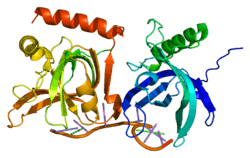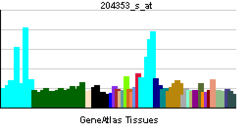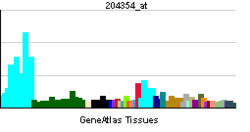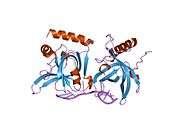POT1
| View/Edit Human | View/Edit Mouse |
Protection of telomeres protein 1 is a protein that in humans is encoded by the POT1 gene.[4][5][6]
Function
This gene is a member of the telombin family and encodes a nuclear protein involved in telomere maintenance. Specifically, this protein functions as a member of a multi-protein complex known as shelterin, that binds to the TTAGGG repeats of telomeres, regulating telomere length and protecting chromosome ends from illegitimate recombination, catastrophic chromosome instability, and abnormal chromosome segregation. Alternatively spliced transcript variants have been described.[6]
Interactions
POT1 has been shown to interact with ACD[7][8][9] and TINF2.[8][9][10]
Pathology
- Increased transcriptional expression of this gene is associated with stomach carcinogenesis and its progression.
- Mutations in this gene have also been associated to the acquisition of the malignant features of chronic lymphocytic leukemia.[11]
- POT1 loss-of-function variants predispose to familial melanoma[12] and glioma.[13]
References
- ↑ "Diseases that are genetically associated with POT1 view/edit references on wikidata".
- ↑ "Human PubMed Reference:".
- ↑ "Mouse PubMed Reference:".
- ↑ Baumann P, Cech TR (May 2001). "Pot1, the putative telomere end-binding protein in fission yeast and humans". Science. 292 (5519): 1171–5. doi:10.1126/science.1060036. PMID 11349150.
- ↑ Baumann P, Podell E, Cech TR (Oct 2002). "Human Pot1 (Protection of Telomeres) Protein: Cytolocalization, Gene Structure, and Alternative Splicing". Mol Cell Biol. 22 (22): 8079–87. doi:10.1128/MCB.22.22.8079-8087.2002. PMC 134737
 . PMID 12391173.
. PMID 12391173. - 1 2 "Entrez Gene: POT1 POT1 protection of telomeres 1 homolog (S. pombe)".
- ↑ Rual JF, Venkatesan K, Hao T, Hirozane-Kishikawa T, Dricot A, Li N, Berriz GF, Gibbons FD, Dreze M, Ayivi-Guedehoussou N, Klitgord N, Simon C, Boxem M, Milstein S, Rosenberg J, Goldberg DS, Zhang LV, Wong SL, Franklin G, Li S, Albala JS, Lim J, Fraughton C, Llamosas E, Cevik S, Bex C, Lamesch P, Sikorski RS, Vandenhaute J, Zoghbi HY, Smolyar A, Bosak S, Sequerra R, Doucette-Stamm L, Cusick ME, Hill DE, Roth FP, Vidal M (Oct 2005). "Towards a proteome-scale map of the human protein-protein interaction network". Nature. 437 (7062): 1173–8. doi:10.1038/nature04209. PMID 16189514.
- 1 2 Ye JZ, Hockemeyer D, Krutchinsky AN, Loayza D, Hooper SM, Chait BT, de Lange T (Jul 2004). "POT1-interacting protein PIP1: a telomere length regulator that recruits POT1 to the TIN2/TRF1 complex". Genes Dev. 18 (14): 1649–54. doi:10.1101/gad.1215404. PMC 478187
 . PMID 15231715.
. PMID 15231715. - 1 2 Liu D, Safari A, O'Connor MS, Chan DW, Laegeler A, Qin J, Songyang Z (Jul 2004). "PTOP interacts with POT1 and regulates its localization to telomeres". Nat. Cell Biol. 6 (7): 673–80. doi:10.1038/ncb1142. PMID 15181449.
- ↑ Loayza D, De Lange T (Jun 2003). "POT1 as a terminal transducer of TRF1 telomere length control". Nature. 423 (6943): 1013–8. doi:10.1038/nature01688. PMID 12768206.
- ↑ Ramsay AJ, Quesada V, Foronda M, Conde L, Martínez-Trillos A, Villamor N, Rodríguez D, Kwarciak A, Garabaya C, Gallardo M, López-Guerra M, López-Guillermo A, Puente XS, Blasco MA, Campo E, López-Otín C (2013). "POT1 mutations cause telomere dysfunction in chronic lymphocytic leukemia". Nat. Genet. 45 (5): 526–30. doi:10.1038/ng.2584. PMID 23502782.
- ↑ Robles-Espinoza CD, Harland M, Ramsay AJ, Aoude LG, Quesada V, Ding Z, Pooley KA, Pritchard AL, Tiffen JC, Petljak M, Palmer JM, Symmons J, Johansson P, Stark MS, Gartside MG, Snowden H, Montgomery GW, Martin NG, Liu JZ, Choi J, Makowski M, Brown KM, Dunning AM, Keane TM, López-Otín C, Gruis NA, Hayward NK, Bishop DT, Newton-Bishop JA, Adams DJ (2014). "POT1 loss-of-function variants predispose to familial melanoma". Nat. Genet. 46 (5): 478–81. doi:10.1038/ng.2947. PMC 4266105
 . PMID 24686849.
. PMID 24686849. - ↑ Bainbridge MN, Armstrong GN, Gramatges MM, Bertuch AA, Jhangiani SN, Doddapaneni H, Lewis L, Tombrello J, Tsavachidis S, Liu Y, Jalali A, Plon SE, Lau CC, Parsons DW, Claus EB, Barnholtz-Sloan J, Il'yasova D, Schildkraut J, Ali-Osman F, Sadetzki S, Johansen C, Houlston RS, Jenkins RB, Lachance D, Olson SH, Bernstein JL, Merrell RT, Wrensch MR, Walsh KM, Davis FG, Lai R, Shete S, Aldape K, Amos CI, Thompson PA, Muzny DM, Gibbs RA, Melin BS, Bondy ML (2015). "Germline mutations in shelterin complex genes are associated with familial glioma". J. Natl. Cancer Inst. 107 (1). doi:10.1093/jnci/dju384. PMID 25482530.
Further reading
- de Lange T (2005). "Shelterin: the protein complex that shapes and safeguards human telomeres". Genes Dev. 19 (18): 2100–10. doi:10.1101/gad.1346005. PMID 16166375.
- Bonaldo MF, Lennon G, Soares MB (1997). "Normalization and subtraction: two approaches to facilitate gene discovery". Genome Res. 6 (9): 791–806. doi:10.1101/gr.6.9.791. PMID 8889548.
- Loayza D, De Lange T (2003). "POT1 as a terminal transducer of TRF1 telomere length control". Nature. 423 (6943): 1013–8. doi:10.1038/nature01688. PMID 12768206.
- Colgin LM, Baran K, Baumann P, Cech TR, Reddel RR (2004). "Human POT1 facilitates telomere elongation by telomerase". Curr. Biol. 13 (11): 942–6. doi:10.1016/S0960-9822(03)00339-7. PMID 12781132.
- Loayza D, Parsons H, Donigian J, Hoke K, de Lange T (2004). "DNA binding features of human POT1: a nonamer 5'-TAGGGTTAG-3' minimal binding site, sequence specificity, and internal binding to multimeric sites". J. Biol. Chem. 279 (13): 13241–8. doi:10.1074/jbc.M312309200. PMID 14715659.
- Kondo T, Oue N, Yoshida K, Mitani Y, Naka K, Nakayama H, Yasui W (2004). "Expression of POT1 is associated with tumor stage and telomere length in gastric carcinoma". Cancer Res. 64 (2): 523–9. doi:10.1158/0008-5472.CAN-03-1196. PMID 14744765.
- Armbruster BN, Linardic CM, Veldman T, Bansal NP, Downie DL, Counter CM (2004). "Rescue of an hTERT Mutant Defective in Telomere Elongation by Fusion with hPot1". Mol. Cell. Biol. 24 (8): 3552–61. doi:10.1128/MCB.24.8.3552-3561.2004. PMC 381596
 . PMID 15060173.
. PMID 15060173. - Liu D, Safari A, O'Connor MS, Chan DW, Laegeler A, Qin J, Songyang Z (2004). "PTOP interacts with POT1 and regulates its localization to telomeres". Nat. Cell Biol. 6 (7): 673–80. doi:10.1038/ncb1142. PMID 15181449.
- Ye JZ, Hockemeyer D, Krutchinsky AN, Loayza D, Hooper SM, Chait BT, de Lange T (2004). "POT1-interacting protein PIP1: a telomere length regulator that recruits POT1 to the TIN2/TRF1 complex". Genes Dev. 18 (14): 1649–54. doi:10.1101/gad.1215404. PMC 478187
 . PMID 15231715.
. PMID 15231715. - Lei M, Podell ER, Cech TR (2005). "Structure of human POT1 bound to telomeric single-stranded DNA provides a model for chromosome end-protection". Nat. Struct. Mol. Biol. 11 (12): 1223–9. doi:10.1038/nsmb867. PMID 15558049.
- Veldman T, Etheridge KT, Counter CM (2005). "Loss of hPot1 function leads to telomere instability and a cut-like phenotype". Curr. Biol. 14 (24): 2264–70. doi:10.1016/j.cub.2004.12.031. PMID 15620654.
- Kelleher C, Kurth I, Lingner J (2005). "Human Protection of Telomeres 1 (POT1) Is a Negative Regulator of Telomerase Activity In Vitro". Mol. Cell. Biol. 25 (2): 808–18. doi:10.1128/MCB.25.2.808-818.2005. PMC 543404
 . PMID 15632080.
. PMID 15632080. - Yang Q, Zheng YL, Harris CC (2005). "POT1 and TRF2 Cooperate To Maintain Telomeric Integrity". Mol. Cell. Biol. 25 (3): 1070–80. doi:10.1128/MCB.25.3.1070-1080.2005. PMC 544002
 . PMID 15657433.
. PMID 15657433. - Lei M, Zaug AJ, Podell ER, Cech TR (2005). "Switching human telomerase on and off with hPOT1 protein in vitro". J. Biol. Chem. 280 (21): 20449–56. doi:10.1074/jbc.M502212200. PMID 15792951.
This article is issued from Wikipedia - version of the 5/20/2016. The text is available under the Creative Commons Attribution/Share Alike but additional terms may apply for the media files.



